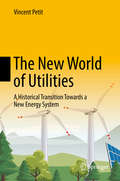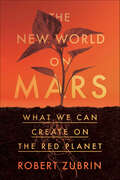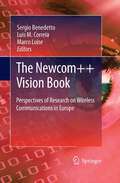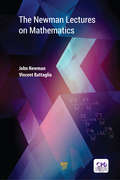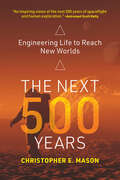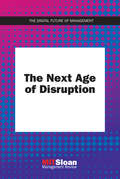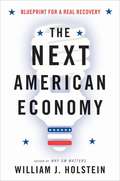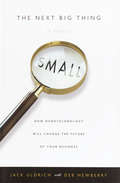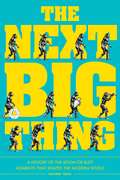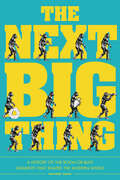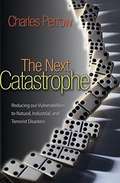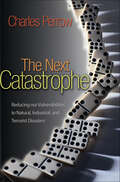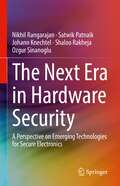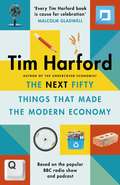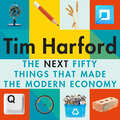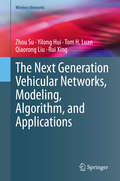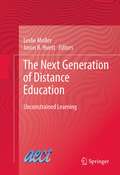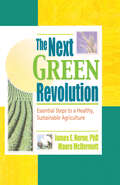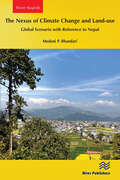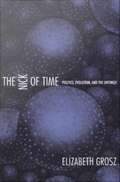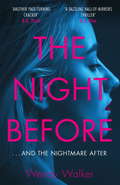- Table View
- List View
The New Starting Right With Bees: A Beginner's Handbook on Beekeeping
by Kim Flottum Kathy SummersThis book is a culmination of nearly 40 years of work by the editors and staff of Gleanings in the Bee Culture. It's primary intent is as a learning tool for beginning beekeepers, but it is an exceptional source of information for anyone interested in the fascinating world of honey bees. This book covers every aspect of introductory beekeeping and honey bee biology--including seasonal management, equipment used, harvesting and marketing hive products, honey bee communication and beekeeping social skills. Beekeeping can become a hobby, a part-time or full-time occupation, but whatever your eventual involvement, this book will make beekeeping easier, since you are Starting Right with Bees.
The New World of Utilities: A Historical Transition Towards a New Energy System
by Vincent PetitAfter decades of stability, power systems are currently undergoing a rapid transition - demand patterns are evolving, while supply sources are shifting to renewable energies at an accelerated pace. This book, written by an experienced energy professional, combines the various aspects of supply and demand developments to offer a unified perspective. It highlights the key changes that the world of electric utilities and power systems will face in the coming decade, as well as the major challenges that will emerge as a result. Supplemented by a wealth of global and local data, the book describes the major patterns that affect both supply and demand, and provides a quantified analysis of their impacts on power system grids and markets. Lastly, it explores the new technologies that can enable the success of these transformations.
The New World on Mars: What We Can Create on the Red Planet
by Robert ZubrinRobert Zubrin, world-renowned space authority and founding president of the Mars Society, taps today’s newest science and most dogged research to foretell in astounding detail the brave, new Martian civilization we will achieve when (not if!) humankind colonizes MarsWhen Robert Zubrin published his classic book The Case for Mars a quarter century ago, setting foot on the Red Planet seemed a fantasy. Today, manned exploration is certain, and as Zubrin affirms in The New World on Mars, so too is colonization. From the astronautical engineer venerated by NASA and today’s space entrepreneurs, here is what we will achieve on Mars and how.SpaceX, Blue Origin, and Virgin Galactic are building fleets of space vehicles to make interplanetary travel as affordable as Old-World passage to America. We will settle on Mars, and with our knowledge of the planet, analyzed in depth by Dr. Zubrin, we will utilize the resources and tackle the challenges that await us. What we will we build? Populous Martian city-states producing air, water, food, power, and more. Zubrin’s Martian economy will pay for necessary imports and generate income from varied enterprises, such as real estate sales—homes that are airtight and protect against cosmic space radiation, with fish-farm aquariums positioned overhead, letting in sunlight and blocking cosmic rays while providing fascinating views. Zubrin even predicts the Red Planet customs, social relations, and government—of the people, by the people, for the people, with inalienable individual rights—that will overcome traditional forms of oppression to draw Earth immigrants. After all, Mars needs talent. With all of this in place, Zubrin’s Red Planet will become a pressure cooker for invention in bioengineering, synthetic biology, robotics, medicine, nuclear energy, and more, benefiting humans on Earth, Mars, and beyond. We can create this magnificent future, making life better, less fatalistic. The New World on Mars proves that there is no point killing each other over provinces and limited resources when, together, we can create planets.
The Newcom++ Vision Book
by Marco Luise Luis M. Correia Sergio BenedettoThe Book contains the Vision of the researchers of the European Network of Excellence NEWCOM++ (Network of Excellence on Wireless COMmunication) on the present and future status of Wireless Communication Networks. In its content, the community of NEWCOM++ researchers, shaped under the common ground of a mainly academic network of excellence, have distilled their scientific wisdom in a number of areas characterized by the common denominator of wireless communications, by identifying the medium-long term research tendencies/problems, describing the tools to face them and providing a relatively large number of references for the interested reader. The identified areas and the researchers involved in their redaction reflect the intersection of the major topics in wireless communications with those that are deeply investigated in NEWCOM++; they are preceded by an original description of the main trends in user/society needs and the degree of fulfilment that ongoing and future wireless communications standards will more likely help achieving. The appendix of the Book contains a list of "Millenium Problems", seminal problems in the area of wireless communication networks, characterized by being crucial and still unsolved. The problems have been identified by NEWCOM++ researchers and filtered by the editors of the Vision Book.
The Newman Lectures on Mathematics
by John Newman Vincent Battaglia<p>Prof. Newman is considered one of the great chemical engineers of his time. His reputation derives from his mastery of all phases of the subject matter, his clarity of thought, and his ability to reduce complex problems to their essential core elements. He is a member of the National Academy of Engineering, Washington, DC, USA, and has won numerous national awards including every award offered by the Electrochemical Society, USA. His motto, as known by his colleagues, is "do it right the first time." He has been teaching undergraduate and graduate core subject courses at the University of California, Berkeley (UC Berkeley), USA, since joining the faculty in 1966. His method is to write out, in long form, everything he expects to convey to his class on a subject on any given day. He has maintained and updated his lecture notes from notepad to computer throughout his career. This book is an exact reproduction of those notes. <p>This book shows a clean and concise way on how to use different analytical techniques to solve equations of multiple forms that one is likely to encounter in most engineering fields, especially chemical engineering. It provides the framework for formulating and solving problems in mass transport, fluid dynamics, reaction kinetics, and thermodynamics through ordinary and partial differential equations. It includes topics such as Laplace transforms, Legendre’s equation, vector calculus, Fourier transforms, similarity transforms, coordinate transforms, conformal mapping, variational calculus, superposition integrals, and hyperbolic equations. The simplicity of the presentation instils confidence in the readers that they can solve any problem they come across either analytically or computationally.</p>
The Newton Wars and the Beginning of the French Enlightenment
by J. B. ShankNothing is considered more natural than the connection between Isaac Newton's science and the modernity that came into being during the eighteenth-century Enlightenment. Terms like "Newtonianism" are routinely taken as synonyms for "Enlightenment" and "modern" thought, yet the particular conjunction of these terms has a history full of accidents and contingencies. Modern physics, for example, was not the determined result of the rational unfolding of Newton's scientific work in the eighteenth century, nor was the Enlightenment the natural and inevitable consequence of Newton's eighteenth-century reception. Each of these outcomes, in fact, was a contingent event produced by the particular historical developments of the early eighteenth century. A comprehensive study of public culture,The Newton Wars and the Beginning of the French Enlightenmentdigsbelow the surface of the commonplace narratives that link Newton with Enlightenment thought to examine the actual historical changes that brought them together in eighteenth-century time and space. Drawing on the full range of early modern scientific sources, from studied scientific treatises and academic papers to book reviews, commentaries, and private correspondence, J. B. Shank challenges the widely accepted claim that Isaac Newton's solitary genius is the reason for his iconic status as the father of modern physics and the philosophemovement.
The Next 500 Years: Engineering Life to Reach New Worlds
by Christopher E. MasonAn argument that we have a moral duty to colonize other planets and solar systems, and a plan for doing so.Inevitably, life on Earth will come to an end, whether by climate disaster, or by cataclysmic war, or when the sun runs out of fuel in a few billion years. To avoid extinction, will we have to find a new home planet, perhaps even a new solar system, to inhabit? In this provocative and fascinating book, Christopher Mason argues that we have a moral duty to do just that. Because we are the only species aware that life on Earth has an expiration date, we have a responsibility to act as the shepherd of lifeforms--not only for our species but for all species on which we depend and for those still to come (by accidental or designed evolution). Mason argues that the same capacity for ingenuity that has enabled us to build rockets and land on other planets can be applied to redesigning biology so that we can sustainably inhabit those planets. And he lays out a 500-year plan for undertaking the massively ambitious project of reengineering human genetics for life in other worlds.
The Next Age of Disruption (The Digital Future of Management)
by MIT Sloan Management ReviewManagement experts discuss the innovation challenges that lie ahead, building on Clayton Christensen's famous theory of "disruptive innovation."Clayton Christensen's groundbreaking theory of "disruptive innovation" has proven to be one of the most influential management ideas of the last several decades. In this book, business and management experts--many of them Christensen's colleagues and former students--discuss the innovation challenges that lie ahead. Building on Christensen's work, they offer companies a guide for navigating a new world of disruption--a future in which artificial intelligence is a business tool, the speed of innovation increases dramatically, and capital is more easily accessible. The book also includes one of the last interviews with Christensen before his death in January 2020.
The Next American Economy: Blueprint for a Real Recovery
by William HolsteinAt a time when debate is raging about how to create jobs and revive the American economy, veteran business writer William J. Holstein argues that the best way for us to recover our economic footing is to do what Americans do best--innovate and create new industries. Contrary to the perception that the American economy has run out of inspiration and new ideas, Holstein uses compelling case studies to celebrate the innovation and business success being experienced in many industries, from technology and energy to retraining and exporting, across the country, from Boston to Orlando, Pittsburgh to San Diego. In the face of economic powerhouses such as Japan and China that are pursuing conscious national strategies, Holstein argues that Americans must find new avenues of cooperation among universities, business, and government to create the kind of sustainable growth we need. Replete with fresh insights into how Americans can create a real economic recovery,The Next American Economyis essential reading for business leaders, politicians, strategists, and anyone who cares about our future.
The Next Big Thing Is Really Small: How Nanotechnology Will Change the Future of Your Business
by Jack Uldrich Deb Newberrynanotechnology \na-no--tek-'nä-l -je-\ n (1987): the science of manipulating material at the atomic levelAlthough nanotechnology deals with the very small—a nanometer is 1/80,000th the diameter of a human hair—it is going to be huge. From the food we eat, the clothes we wear, and the products we manufacture to the composition of our bodies, everything is made of atoms. And if we can manipulate the atom, then that changes the rules of the game for almost every product.Coal and diamonds, for example, are both constructed from carbon atoms. It’s merely the arrangement of the atoms that differentiates an inexpensive fuel source from a pricey engagement jewel. While the science of nanotech cannot yet transform coal into diamonds, it is advancing rapidly and will begin to radically alter the business world during the next few years—and will continue to do so for the forseeable future. The buzz surrounding nanotech is comparable to that at the dawn of the digital revolution, which changed the face of how business operates. Unlike the Internet, however, which applied new technology to many old processes and businesses, nanotech is about creating entirely new materials, products, and systems (and therefore markets), as well as making existing products faster, stronger, and better.You may be tempted to wait until the buzz dies down before deciding how to integrate nanotech into your business, but don’t make the mistake of thinking of it as being light-years away. Even though it may sound far-off at times, within ten years nanotech will have huge effects on many industries, including manufacturing, health care, energy, agriculture, communications, transportation, and electronics. Within a decade, nanotechnology is expected to be the basis of $1 trillion worth of products in the United States alone and will create anywhere from 800,000 to 2 million new jobs. Nanotechnology will require you to radically re-think what your core business is, who your competitors are, what skills your workforce needs, how to train your employees, and how to think strategically about the future. Jack Uldrich and Deb Newberry explain exactly how you should prepare for nanotech’s imminent arrival. They identify today’s nanotech innovators, chronicle and project the rapid rise of nanotech developments, and show how to think strategically about the field’s opportunities and investments. The Next Big Thing Is Really Small provides a sneak peek at the technology that will transform the next ten years, giving investors and executives a road map for using small wonders to generate big profits.
The Next Big Thing: A History of the Boom-or-Bust Moments That Shaped the Modern World
by Richard FaulkWe are always hearing about the Next Big Thing. Whether it is a new iPhone or the New World, the freshest and newest inventions, discoveries, and fads loom large in the public mind. The impact that everyone thinks these "next big things" will have is often more important than the actual impact it generates. After all, if it fails, it will be almost immediately forgotten. The Next Big Thing searches through 3,000 years of Western culture to find the colorful and key steps (and missteps) that led us to where we are today. Paradigm-shifting events, such as the spread of ethical monotheism and the invention of the printing press stand beside such cultural ephemera as the aborted U.S metric campaign and the misbegotten vogue for smart drinks. Each entry features the historical context of that Next Big Thing as well as an overview of its legacy, including photos, sidebars, trivia, and quotes.
The Next Big Thing: A History of the Boom-or-Bust Moments That Shaped the Modern World
by Richard FaulkWe are always hearing about the Next Big Thing. Whether it is a new iPhone or the New World, the freshest and newest inventions, discoveries, and fads always loom large in the public mind. The impact that everyone thinks these "next big things" will have is often more important than the actual impact it generates. After all, if it fails, it will be almost immediately forgotten. The Next Big Thing searches through 3,000 years of Western culture to find the colorful and key steps (and missteps) that led us to where we are today.
The Next Catastrophe: Reducing Our Vulnerabilities to Natural, Industrial, and Terrorist Disasters
by Charles PerrowCharles Perrow is famous worldwide for his ideas about normal accidents, the notion that multiple and unexpected failures--catastrophes waiting to happen--are built into our society's complex systems. In The Next Catastrophe, he offers crucial insights into how to make us safer, proposing a bold new way of thinking about disaster preparedness. Perrow argues that rather than laying exclusive emphasis on protecting targets, we should reduce their size to minimize damage and diminish their attractiveness to terrorists. He focuses on three causes of disaster--natural, organizational, and deliberate--and shows that our best hope lies in the deconcentration of high-risk populations, corporate power, and critical infrastructures such as electric energy, computer systems, and the chemical and food industries. Perrow reveals how the threat of catastrophe is on the rise, whether from terrorism, natural disasters, or industrial accidents. Along the way, he gives us the first comprehensive history of FEMA and the Department of Homeland Security and examines why these agencies are so ill equipped to protect us. The Next Catastrophe is a penetrating reassessment of the very real dangers we face today and what we must do to confront them. Written in a highly accessible style by a renowned systems-behavior expert, this book is essential reading for the twenty-first century. The events of September 11 and Hurricane Katrina--and the devastating human toll they wrought--were only the beginning. When the next big disaster comes, will we be ready?
The Next Catastrophe: Reducing our Vulnerabilities to Natural, Industrial, and Terrorist Disasters
by Charles PerrowCharles Perrow is famous worldwide for his ideas about normal accidents, the notion that multiple and unexpected failures--catastrophes waiting to happen--are built into our society's complex systems. In The Next Catastrophe, he offers crucial insights into how to make us safer, proposing a bold new way of thinking about disaster preparedness. Perrow argues that rather than laying exclusive emphasis on protecting targets, we should reduce their size to minimize damage and diminish their attractiveness to terrorists. He focuses on three causes of disaster--natural, organizational, and deliberate--and shows that our best hope lies in the deconcentration of high-risk populations, corporate power, and critical infrastructures such as electric energy, computer systems, and the chemical and food industries. Perrow reveals how the threat of catastrophe is on the rise, whether from terrorism, natural disasters, or industrial accidents. Along the way, he gives us the first comprehensive history of FEMA and the Department of Homeland Security and examines why these agencies are so ill equipped to protect us.The Next Catastrophe is a penetrating reassessment of the very real dangers we face today and what we must do to confront them. Written in a highly accessible style by a renowned systems-behavior expert, this book is essential reading for the twenty-first century. The events of September 11 and Hurricane Katrina--and the devastating human toll they wrought--were only the beginning. When the next big disaster comes, will we be ready? In a new preface to the paperback edition, Perrow examines the recent (and ongoing) catastrophes of the financial crisis, the BP oil spill, and global warming.
The Next Era in Hardware Security: A Perspective on Emerging Technologies for Secure Electronics
by Ozgur Sinanoglu Nikhil Rangarajan Satwik Patnaik Johann Knechtel Shaloo RakhejaThis book provides a comprehensive coverage of hardware security concepts, derived from the unique characteristics of emerging logic and memory devices and related architectures. The primary focus is on mapping device-specific properties, such as multi-functionality, runtime polymorphism, intrinsic entropy, nonlinearity, ease of heterogeneous integration, and tamper-resilience to the corresponding security primitives that they help realize, such as static and dynamic camouflaging, true random number generation, physically unclonable functions, secure heterogeneous and large-scale systems, and tamper-proof memories. The authors discuss several device technologies offering the desired properties (including spintronics switches, memristors, silicon nanowire transistors and ferroelectric devices) for such security primitives and schemes, while also providing a detailed case study for each of the outlined security applications. Overall, the book gives a holistic perspective of how the promising properties found in emerging devices, which are not readily afforded by traditional CMOS devices and systems, can help advance the field of hardware security.
The Next Fifty Things that Made the Modern Economy
by Tim Harford'Endlessly insightful and full of surprises - exactly what you would expect from Tim Harford' BILL BRYSON'Entertaining . . . A lively introduction to some of the most ingenious, yet often overlooked inventions that have changed the way we live' The Times'Every Tim Harford book is cause for celebration' MALCOLM GLADWELL'Harford is a fine, perceptive writer, and an effortless explainer of tricky concepts. His book teems with good things, and will expand the mind of anyone lucky enough to read it' Daily MailIn Fifty Things that Made the Modern Economy, the revolutionary, acclaimed book, radio series and podcast, bestselling economist Tim Harford introduced us to a selection of fifty radical inventions that changed the world.Now, in this new book, Harford once again brings us an array of remarkable, memorable, curious and often unexpected 'things' - inventions that teach us lessons by turns intimate and sweeping about the complex world economy we live in today.From the brick, blockchain and the bicycle to fire, the factory and fundraising, and from solar PV and the pencil to the postage stamp, this brilliant and enlightening collection resonates, fascinates and stimulates. It is a wonderful blend of insight and inspiration from one of Britain's finest non-fiction storytellers.
The Next Fifty Things that Made the Modern Economy
by Tim Harford'Endlessly insightful and full of surprises - exactly what you would expect from Tim Harford' BILL BRYSON'Entertaining . . . A lively introduction to some of the most ingenious, yet often overlooked inventions that have changed the way we live' The Times'Every Tim Harford book is cause for celebration' MALCOLM GLADWELL'Harford is a fine, perceptive writer, and an effortless explainer of tricky concepts. His book teems with good things, and will expand the mind of anyone lucky enough to read it' Daily MailIn Fifty Things that Made the Modern Economy, the revolutionary, acclaimed book, radio series and podcast, bestselling economist Tim Harford introduced us to a selection of fifty radical inventions that changed the world.Now, in this new book, Harford once again brings us an array of remarkable, memorable, curious and often unexpected 'things' - inventions that teach us lessons by turns intimate and sweeping about the complex world economy we live in today.From the brick, blockchain and the bicycle to fire, the factory and fundraising, and from solar PV and the pencil to the postage stamp, this brilliant and enlightening collection resonates, fascinates and stimulates. It is a wonderful blend of insight and inspiration from one of Britain's finest non-fiction storytellers.
The Next Generation Vehicular Networks, Modeling, Algorithm and Applications (Wireless Networks)
by Tom H. Luan Zhou Su Yilong Hui Qiaorong Liu Rui XingThis book proposes the novel network envisions and framework design principles, in order to systematically expound the next generation vehicular networks, including the modelling, algorithms and practical applications. It focuses on the key enabling technologies to design the next generation vehicular networks with various vehicular services to realize the safe, convenient and comfortable driving. The next generation vehicular networks has emerged to provide services with a high quality of experience (QoE) to vehicles, where both better network maintainability and sustainability can be obtained than before.The framework design principles and related network architecture are also covered in this book. Then, the series of research topics are discussed including the reputation based content centric delivery, the contract based mobile edge caching, the Stackelberg game model based computation offloading, the auction game based secure computation offloading, the bargain game based security protection and the deep learning based autonomous driving. Finally, the investigation, development and future works are also introduced for designing the next generation vehicular networks.The primary audience for this book are researchers, who work in computer science and electronic engineering. Professionals working in the field of mobile networks and communications, as well as engineers and technical staff who work on the development or the standard of computer networks will also find this book useful as a reference.
The Next Generation of Distance Education
by Jason B. Huett Leslie MollerThe world of education is being radically altered with the change being driven by technology, openness, and unprecedented access to knowledge. Older correspondence-style methods of instructional delivery are passé and "classroom adapted to the web" approaches to learning are often ineffective and do little to harness the transformational potential of technology. E-Learning scenarios, mobile technologies, communication and information access, and personal learning environments are becoming mainstream and, as a result, control of the learning process is shifting away from institutions and into the hands of learners. This volumes promotes a forward-thinking agenda for research and scholarship that highlights new ideas, deep insights, and novel approaches to "unconstrained" learning.
The Next Green Revolution: Essential Steps to a Healthy, Sustainable Agriculture
by Jim Horne Raymond P Poincelot Maura McdermottExplore the benefits of and necessity for sustainable agriculture!Here is an easy-to-read, practical introduction to sustainable agriculture: what it means and why it is needed. It is the first book to synthesize the goals of sustainable agriculture into eight comprehensive steps. The Next Green Revolution presents a convincing critique of our current agricultural system and an introduction to an alternative system which gives more consideration to future generations. Interwoven through the book are Dr. Horne's reflections on social justice, quality of life, and how farmers and rural communities are inextricably linked.The Next Green Revolution draws on the unique perspective of Dr. James E. Horne, President of a leading nonprofit agriculture organization, the Kerr Center for Sustainable Agriculture. It is inspired by his experience as a traditional agriculturalist and educator coming to grips with the failings of the conventional system and searching for an alternative. Writing in the first person, he describes growing up in a sharecropper family in Oklahoma, running his own ranch, and consulting with farmers as an agricultural economist. He shares what he learned as the Kerr Center experimented with new “sustainable” approaches to old problems on the Center's ranch/farm, and his experiences working with the USDA's Sustainable Agriculture Research and Education Program. With The Next Green Revolution, you will explore: the major problems of contemporary industrial agriculture definitions of sustainable agriculture the historical roots of sustainable agriculture the politics of sustainable agriculture sustainable agriculture practices changes needed to encourage a sustainable agriculture and the eight steps to sustainable agriculture, which address: soil health and erosion water quality and use organic waste management crop and livestock adaptation biodiversity environmentally benign pest management energy use farm diversification profitability The Next Green Revolution is a well-researched introduction to the field, written with a minimum of jargon.
The Next One Hundred Years: Shaping the Fate of Our Living Earth
by Jonathan WeinerA detailed but non-technical analysis of the state of the planet today and during the next century by the author of Planet Earth.
The Next Wave: The Quest to Harness the Power of the Oceans (Scientists in the Field Series)
by Elizabeth RuschJourney to the wave-battered coast of the Pacific Northwest to meet some of the engineers and scientists working to harness the punishing force of our oceans, one of the nature’s powerful and renewable energy sources. With an array of amazing devices that cling to the bottom of the sea floor and surf on the crests of waves, these explorers are using a combination of science, imagination, and innovation to try to capture wave energy in the hopes of someday powering our lives in a cleaner, more sustainable way.
The Nexus of Climate Change and Land-use – Global Scenario with Reference to Nepal
by Medani P. BhandariThe interplay between land use and climate change is a crucial aspect of sustainable development, especially in Nepal. This book delves into the intricate connections between land-use and climate change in Nepal, shedding light on significant challenges and potential opportunities. Nepal, with its diverse topography and ecosystems, is exceptionally susceptible to the impacts of climate change. The distinctive land-use patterns, encompassing agriculture, forest cover, and urbanization, significantly influence the country's climate resilience and carbon balance. However, rapid population growth, urban expansion, and changing land-use practices have led to environmental degradation and a surge in greenhouse gas emissions. The alarming deforestation, driven by agricultural expansion, infrastructure development, and unsustainable logging, has contributed to carbon emissions and the depletion of vital ecosystem services. Consequently, the conversion of forested land into agricultural fields has negatively affected biodiversity, soil erosion, and water resources, intensifying the vulnerability of communities to climate change. Nevertheless, embracing sustainable land-use practices like afforestation, reforestation, and agroforestry holds promise for mitigating the impacts of climate change and enhancing resilience. The promotion of climate-smart agriculture, watershed management, and community-based forestry can aid in conserving ecosystems, sequestering carbon, and improving livelihoods. This study illustrates the intricate relationship between land-use and climate change, emphasizing the importance of striking a balance in land-use practices, conserving forests, and biodiversity, and promoting sustainable agriculture. These efforts are indispensable for achieving climate resilience and sustainable development in Nepal. By addressing the nexus between land-use and climate change, Nepal can pave the way towards a more sustainable and climate-resilient future. The purpose of this book is to present the core concepts of this issue, inspire further research, and propose solutions to mitigate the problems caused by human disturbances in the Earth's ecosystem.
The Nick of Time: Politics, Evolution, and the Untimely
by Elizabeth GroszIn this pathbreaking philosophical work, Elizabeth Grosz points the way toward a theory of becoming to replace the prevailing ontologies of being in social, political, and biological discourse. Arguing that theories of temporality have significant and underappreciated relevance to the social dimensions of science and the political dimensions of struggle, Grosz engages key theoretical concerns related to the reality of time. She explores the effect of time on the organization of matter and on the emergence and development of biological life. Considering how the relentless forward movement of time might be conceived in political and social terms, she begins to formulate a model of time that incorporates the future and its capacity to supersede and transform the past and present. Grosz develops her argument by juxtaposing the work of three major figures in Western thought: Charles Darwin, Friedrich Nietzsche, and Henri Bergson. She reveals that in theorizing time as an active, positive phenomenon with its own characteristics and specific effects, each of these thinkers had a profound effect on contemporary understandings of the body in relation to time. She shows how their allied concepts of life, evolution, and becoming are manifest in the work of Gilles Deleuze and Luce Irigaray. Throughout The Nick of Time, Grosz emphasizes the political and cultural imperative to fundamentally rethink time: the more clearly we understand our temporal location as beings straddling the past and the future without the security of a stable and abiding present, the more transformation becomes conceivable.
The Night Before: ‘A dazzling hall-of-mirrors thriller' AJ Finn
by Wendy Walker'Ferociously smart.' AJ Finn'Another page-turning cracker' BA ParisFIRST DATES CAN BE MURDER...Laura has never been lucky in love. She falls too hard and too fast, always choosing the wrong men. Devastated by the end of her last relationship, she fled her apartment for her sister's home in the suburb where they both grew up. Though still haunted by the tragedy that's defined her entire life, Laura is determined to take one more chance on love with a man she's met on an Internet dating site.Rosie has spent most of her life worrying about her troubled sister. Laura's return, under mysterious circumstances, has cast a shadow over Rosie's peaceful life with her husband and young son - a shadow that grows darker as Laura leaves the house for her blind date.When Laura doesn't return home the following morning, Rosie fears the worst. She's not responding to calls or texts, and she's left no information about the man she planned to meet. As Rosie begins a desperate search to find her sister, she is not just worried about what this man might have done to Laura. She's worried about what Laura may have done to him...'Riveting.' Riley Sager 'Addictive.' Liv Constantine 'Wonderfully tense.' Aimee Molloy 'Irresistible.' Mary Kubica 'Impossible to put down.' Megan Miranda

